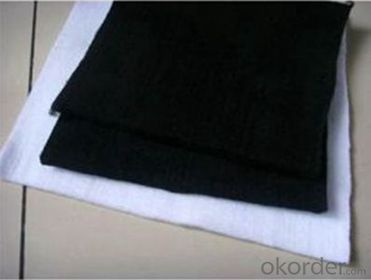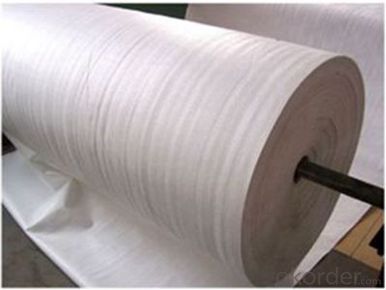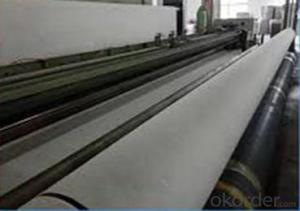Needle Punched & Geotextile Non-woven for Road Cconstruction
- Loading Port:
- China main port
- Payment Terms:
- TT OR LC
- Min Order Qty:
- 5000 m²
- Supply Capability:
- 1000000 m²/month
OKorder Service Pledge
OKorder Financial Service
You Might Also Like
Item specifice
Property:
1.super high strength,ultralight,high resistance
2.Resistance to chemical erosion,excellent water resistance
3.Abrasion resistant
4.Excellent anti-aging and anti-UV property,good weather fastness
Application:
1.Separation and stabilization in road and railway construction
2.Reinforcement project
Photos:



Packaging & Shipping
Packing: PLASTIC FILM INSIDE, AND WOVEN BAG OUTSIDE
Shipping: About 15 days after receipt the deposit
geotextile fabric
permeability,filtration,easy for construction
ISO and CE certificate
Good quality and competitive price
Our Service
Quality assurance
1.On a regular basis or as per your request,we entrust national testing agencies to conduct quality inspections
2. Strictly in accordance with the ISO9001-2008 international quality system standard,we monitor and manage the whole process throughout production,quality testing,and measurement to ensure product quality
3. For quality-related construction delay or substandard construction(except for damage or losses due to customer’s responsibility or irresistible natural disasters),we have refunding,replacement,and repair services.We will respond to customers’ feedbacks on quality issues within 24 hours.
After-sales service
1.In order to provide customers with comprehensive technical support,we will provide technical and other related information upon request in a timely manner.
2.In required,we will appoint specialized technicians to the construction site to give technical trainings to construction people,and offer technical guidance throughout the whole construction process.
3.For damage due to shipment and delivery,after we receive the complaint,we will check the issure through provided pictures and videos.If our responsibility is confirmed,we wil offer free replacement.
4.When the construction is completed,as your request,our technical staff may participate in the final acceptance.
FAQ:
Q: What kind of payments does jenor support?
A: T/T, L/C, Cash are accepted.
Q: Do you charge for the samples?
A: Accordeing to our company policy, the samples are free, we only charge the freight fee. And we will return the freight fee during the next order.
Q: Can you produce according to customers' design?
A: Sure, we are professional manufacturer, OEM and ODM are both welcome.
Q: Do you have other products?
A: Yes, please check the pictures:
- Q:What is the difference between woven and non-woven geotextiles?
- Woven geotextiles are made by weaving continuous individual yarns together, creating a strong and durable fabric. On the other hand, non-woven geotextiles are made by bonding or felting together synthetic fibers, resulting in a fabric that is not as strong or durable as woven geotextiles. Woven geotextiles provide higher tensile strength, better filtration, and are typically used in applications that require greater longevity and stability. Non-woven geotextiles, while less durable, are often used for filtration and separation purposes due to their high water flow rates and ability to retain fine particles.
- Q:What are the factors to consider when designing geotextile tubes for dewatering?
- When designing geotextile tubes for dewatering, there are several factors to consider. Firstly, the type and characteristics of the sediment or sludge being dewatered should be evaluated, including its composition, particle size distribution, and consolidation properties. This information will help determine the appropriate geotextile fabric and pore size required to effectively retain the solids while allowing water to drain. Secondly, the hydraulic loading conditions need to be considered. The flow rate, pressure, and duration of the dewatering process will influence the required strength and permeability of the geotextile tubes. Adequate strength is crucial to withstand the hydraulic forces and prevent structural failure. Additionally, the site conditions and environmental factors should be taken into account. The stability of the ground where the geotextile tubes will be placed, as well as any potential erosion or slope stability issues, should be thoroughly analyzed. The project location, climate, and potential impact on surrounding ecosystems should also be considered to ensure the chosen design is sustainable and minimizes any adverse effects. Lastly, the cost-effectiveness and practicality of the design should be evaluated. Factors such as the availability and cost of materials, installation methods, and maintenance requirements should be considered to optimize the overall dewatering process. Overall, designing geotextile tubes for dewatering requires a comprehensive assessment of sediment characteristics, hydraulic loading conditions, site conditions, and cost-effectiveness to ensure a successful and efficient dewatering solution.
- Q:Geotextile and geogrid the same do
- Not the same, this is two kinds of products, my user name professional manufacturer phone! The The
- Q:The difference between lap and stitching
- In terms of popularity, the lap is a kind of overlapping, overlapping with each other interface method; and seam law is not overlapping, the use of docking method, will inevitably leave the gap, so called seam method. These two methods are used for geotextile construction, the construction requirements: When the use of lap connection, lap length should be 0.3 ~ 0.9m, the use of seam method, the bonding width of not less than 50mm, bonding strength of not less than The tensile strength of the material. On-site construction of the upper and lower joints should be staggered, staggered length of not less than 0.5m.
- Q:Related applications, product applications, industrial structure and distribution
- Road cloth, that is, geotextile, also known as geotextile, it is made of synthetic fibers through the needle or woven from the permeability of geosynthetics. Geotextile is a new material geosynthetics which one, the finished product for the cloth, the general width of 4-6 meters, the length of 50-100 meters. Geotextile is divided into a woven geotextile and non-woven geotextile. Geotextile with excellent filtration, drainage, isolation, reinforcement, protection, with a light weight, high tensile strength, good permeability, high temperature, anti-freeze, anti-aging, corrosion resistance characteristics. The application of geosynthetics originated in the 1950s, the domestic geotextile is one of the national eight five plan, China promulgated in 1998, "geosynthetics staple acupuncture non-woven geotextile" (GB / T -1998) standard, the current geotextile has been widely used in many areas. Geotextile mainly in the following three series: 1, acupuncture non-woven geotextile, specifications 100g / m2-600g / m2 between any choice, the main raw material is the use of polyester staple fiber or polypropylene staple fiber, made by acupuncture, Uses are: river, sea, lake embankment slope protection, reclamation, wharf, ship lock flood control and other projects, is through the filter to play a soil and water conservation and effective way to prevent piping. 2, acupuncture non-woven and PE film composite geotextile, specifications have a cloth a film, two cloth a film, the largest width of 4.2 meters The main raw material is to use polyester staple fiber non-woven, PE film through the composite , The main purpose is anti-seepage, apply to railways, highways, tunnels, subways, airports and other projects. 3, non-woven and woven composite geotextile, a variety of non-woven and polypropylene filament woven composite, non-woven and plastic woven composite, suitable for foundation reinforcement, adjust the permeability coefficient of the basic engineering facilities.
- Q:How do geotextiles help with soil separation and stabilization?
- Geotextiles help with soil separation by acting as a barrier that prevents the mixing of different soil layers. They also aid in soil stabilization by providing reinforcement and strength to the soil, reducing erosion and maintaining the stability of the ground.
- Q:How do geotextiles help with sediment retention in sediment basins?
- Geotextiles help with sediment retention in sediment basins by acting as a barrier that filters and separates sediment from water. They allow water to pass through while trapping and retaining sediment particles, preventing them from being washed away. This helps to reduce erosion and sedimentation in the basins, promoting cleaner water discharge and maintaining the overall effectiveness of the sediment basin.
- Q:Will geotextiles generally use where?
- Water conservancy project dam and slope protection of the filter, channel isolation, anti - seepage. ⒉ road, railway, airport runway foundation isolation, filter, drainage, soil slope, retaining wall and road reinforcement, drainage. ⒊ port engineering soft foundation treatment, beach embankment, harbor wharf and breakwater reinforcement, drainage. ⒋ landfill, thermal power plant ash dam, mine tailings dam isolation, seepage control.
- Q:How do geotextiles help in preventing the growth of weeds?
- Geotextiles help in preventing the growth of weeds by acting as a physical barrier between the soil and the environment. These permeable fabrics are designed to allow water and air to pass through but inhibit the growth of weeds by blocking sunlight, which is essential for weed germination and growth. Additionally, geotextiles can also prevent weed seeds from reaching the soil, thus minimizing the potential for weed growth.
- Q:How do geotextiles help in soil reinforcement?
- Geotextiles help in soil reinforcement by providing a strong and stable layer that improves the overall load-bearing capacity of the soil. They act as a barrier, preventing soil erosion and promoting water drainage, which helps in maintaining the integrity of the soil structure. Additionally, geotextiles distribute the applied load more evenly, reducing the risk of soil settlement and improving the stability of slopes and embankments.
1. Manufacturer Overview |
|
|---|---|
| Location | |
| Year Established | |
| Annual Output Value | |
| Main Markets | |
| Company Certifications | |
2. Manufacturer Certificates |
|
|---|---|
| a) Certification Name | |
| Range | |
| Reference | |
| Validity Period | |
3. Manufacturer Capability |
|
|---|---|
| a)Trade Capacity | |
| Nearest Port | |
| Export Percentage | |
| No.of Employees in Trade Department | |
| Language Spoken: | |
| b)Factory Information | |
| Factory Size: | |
| No. of Production Lines | |
| Contract Manufacturing | |
| Product Price Range | |
Send your message to us
Needle Punched & Geotextile Non-woven for Road Cconstruction
- Loading Port:
- China main port
- Payment Terms:
- TT OR LC
- Min Order Qty:
- 5000 m²
- Supply Capability:
- 1000000 m²/month
OKorder Service Pledge
OKorder Financial Service
Similar products
New products
Hot products
Related keywords
































